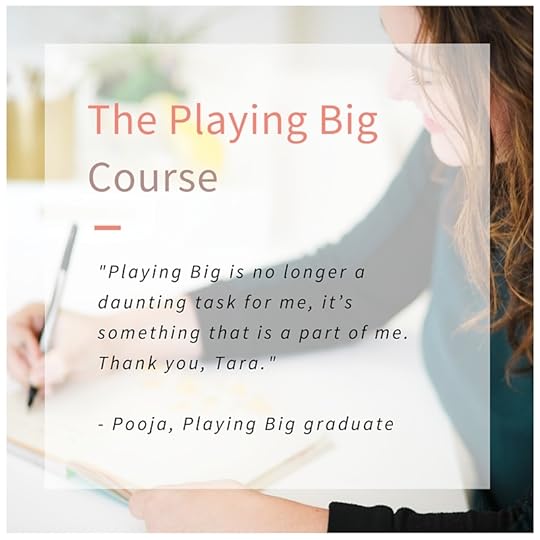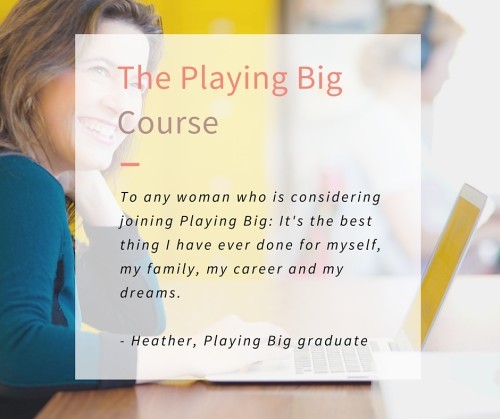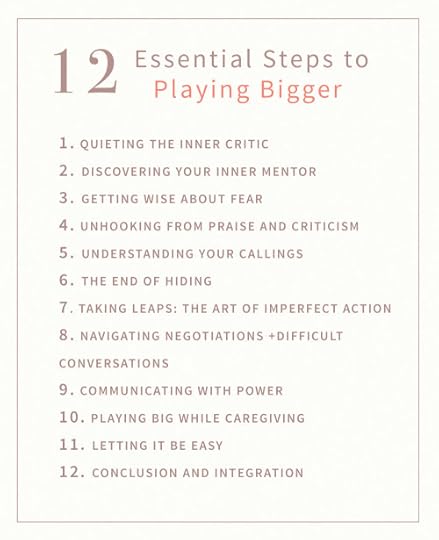Tara Mohr's Blog, page 19
August 10, 2016
Beyond Political

I could start this post with, “I don’t usually write about political topics…,” except that the word “political” doesn’t feel quite right to describe what’s unfolding before us now.
What is happening in my country has firmly left the realm of politics. We are now in the realm of the civic and the human. We are in the realm of choosing violence or nonviolence. We are in the realm of choosing between the delusions of othering or the truth of common humanity, of leaning toward emotional maturity or pathological emotional volatility. We are in the realm of protecting love, grappling with the rise of fear, seeing challenges to our long-held notions of human rights.
For eight years I’ve written here about our human potential, the forces that constrain it and the shifts that can unleash it. I’ve written about the legacy of women’s marginalization and this remarkable moment of change that you and I were born into, when women are stepping into our power. To not write about what is happening in my country, and how it relates to these issues, would be nonsensical.
And it would be my own fearful, people-pleasing way of playing small.
So, I want to let you know that I will be writing more in the next few months about the upcoming U.S. election, the movements surrounding it, the perceptions we hold of it – and how all of that relates to the things we’ve long talked about here.
My readers here are politically diverse (something I cherish) and I want you to know, whatever your views, I respect them, and you are welcome here. I know for a fact we have the most important things in common.
I don’t do othering. I don’t think one party or place on the political spectrum has a monopoly on truth. I think we all need to be speaking up right now. So I’ll speak my view of what’s happening and I open-heartedly invite you to speak yours.
Stay tuned for more, and if you are reading this via my email list, see the P.S. below if you prefer to opt out of election-related emails.
With love,
Tara
July 22, 2016
Is your relationship to money working for you?
Growing up, I got the message that it was totally acceptable for women to avoid the financial realm of life; the money stuff was the men’s problem.
Over the past decade, one of the most fulfilling personal shifts I’ve made has been to become more proactive about the money realm of my life — absorbing more financial education, and generally facing – not avoiding – the details of financial management that a conscious life requires.
When I encountered Bari Tessler’s work, however, I went from pushing myself to be more in touch with my money situation to loving being in touch with my money situation. Looking at the books, reflecting on what’s there, and making shifts accordingly, has become one of my favorite ways to spend my time. Believe me; I could never have predicted that.
So today, I’m very happy to share with you a little about Bari’s work. She has a new book out that’s so helpful, that I recommend highly.
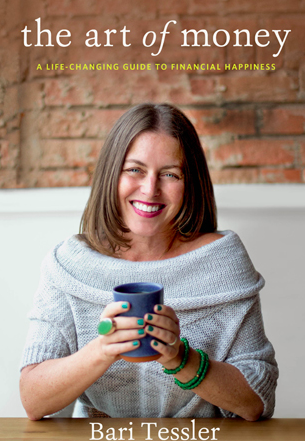
I asked Bari to share with us a little about her work.
TARA: How did you come to be working with people around their relationship to money?
BARI: Never in a million years did I think I would be a Financial Therapist supporting people in their money relationship. In my early twenties, I decided I wanted to be a therapist, but I assumed I would tackle topics like sexuality, sensuality, food, body, intimacy and relationships. It took a long time for me to realize that the portal I would use to beckon people into more mindfulness, compassion, and intimacy was money.
By the time I was in graduate school at Naropa (studying somatic psychology, authentic movement, and rites of passage), I began to realize that financial literacy — of any kind — was a huge missing piece in my education.
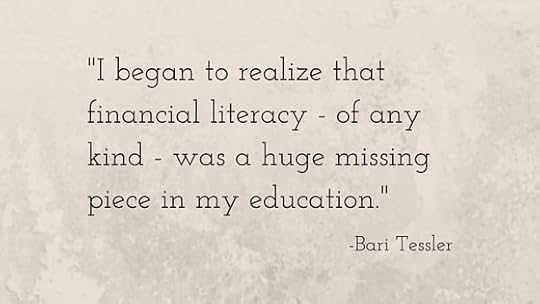
Even in my incredible graduate program, where we acted as our own case studies and scrutinized our relationship with every topic under and beyond the sun, we never talked about money or our relationship with it.
For me, this all came crashing to a head just after I graduated — the day I got my first student loan bill in the mail. I didn’t know how on earth I was going to make those minimum monthly payments. I didn’t know how I was going to find meaningful work in the world — a career that utilized my gifts, served my community, and allowed me to thrive, financially. I felt ashamed that I didn’t somehow already know how to do all of this “money stuff.”
That day, I made a life-changing decision. I wasn’t going to run away. I was going to look money in the eye and figure it out.

And I was going to do it my way, which meant understanding money on a practical, emotional, psychological and spiritual level. I was going to listen to my body’s wisdom through it all. I was going to infuse it with my values (deeper meaning, playfulness, creativity, beauty, serving others) and everything that mattered most to me.
I started learning everything I could about money. I stayed up late reading about bookkeeping and accounting. I learned QuickBooks and hung up my shingle as a bookkeeper. I started doing bookkeeping for artists, healers, and creative folks, who often handed off their “money stuff” to me like a hot potato: they were ecstatically relieved not to have to deal with this icky area of life anymore.
Everyone around me, no matter their income level, background, religion, or musical tastes, was suffering around money in some way. Most of us never learned how to manage money, let alone navigate our feelings and emotions about it.
I began guiding small groups of really brave people into deep money work. Over many years, I led group after group, honing my methodology. We examined our money stories. We shed our shame and created money healing rituals. We explored how our income and expenses could become sacred vessels for our values. And we also shared our numbers and got smart about savvy tools and practices.
On June 14th, my first book, The Art of Money: A Life-Changing Guide to Financial Happiness, was born into the world.

TARA: It is amazing to think about how often we don’t get that education, and how therapists are often trained to look specifically at so many areas of life – but not this one.
What’s one money issue you see coming up for women in particular?
BARI: I don’t love making generalizations about women-specific issues. So many of the issues people face with money are universal. That being said, one theme that comes to mind is VALUE. Again: this is true for many men, as well, but I see more women struggling with this.
Many women arrive at my doorstep struggling with profound questions about money and value. How can I honor my value within my money relationship? What does that even mean? How can I claim my value? How can I FEEL my value, in my bones? How can I translate my inner sense of self-worth into my earning, spending, saving, and gifting? These questions cut very deep, very quickly. They’re about money — but they’re never just about money.
Many people have attempted to answer these questions with the modern mantra, “charge what you’re worth.” This is well-intentioned, but it utterly misses the mark. We are worthy simply by being born a unique, precious human being — and this has nothing to do with how much money is in our bank accounts or even what we charge for our services. To charge what we’re “worth” would be infinite and incalculable.
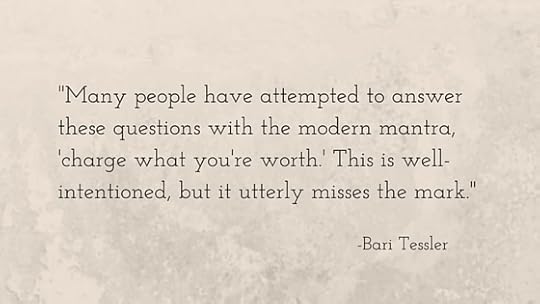
By starting with the inner work of claiming our value, we can translate our self-worth into external actions. We can stop over-yes-ing and under-no-ing, over-giving and under-receiving. We can take strong (if baby) steps towards healthier, more empowered relationships with money and every aspect of our lives.
TARA: That certainly resonates with me. Before we wrap up, I wanted to share with everyone three takeaways from the book that I found super helpful.
1. Most of us have some kind of money shame. It might be about the wealth have, or came from, or the resources we don’t have. It might be about financial mistakes of the past. Whatever the cause, that shame keeps us stuck in unhealthy patterns. For me, just reading the stories of others’ money shame was very healing.
2. It’s okay to make Money Dates fun. Reading about your ritual of how you go over your books – candlelit, dark chocolate by your side – was such a revelation to me. I started to think about how I can have more of that sensibility, that this is a special time of self-care, and it really changed how I approach those sessions.
3. Pay attention to how you name your spending. You talk about how, in budgeting, it can be so powerful not to just write “mortgage” on the balance sheet, but “Home” or “Sanctuary.” To not just write “Food” but “Nourishment” or even “Healthy Family” or whatever that category is really about for the person. In this way, we start to see spending as not just a drain on resources, but a reflection of our values – or we notice where it isn’t. And you also write about how we name and think of our debt matters, looking honestly at what was going on during the period we accrued it, and honoring it – whether it was schooling or an unpaid maternity leave or just a painful time in our lives. When we see what that time was about, and what it gave us, we can feel less resentful – and therefore motivated to move forward it paying it off.
So tell our readers, where can we get the book?
BARI: I am beyond excited to share my book with you! It’s so many years in the making, and I couldn’t be happier with it. It includes my entire, 3-phase methodology (Money Healing, Money Practices, and Money Maps), woven together through intimate stories from my own money journey and those of my dear community and colleagues. It’s warm, un-shaming, and includes simple tools and practices anyone can start using, right now, to transform their relationship with money. (Watch a short video of Bari reading from the book at her favorite local bookstore, here.)
The Art of Money: A Life-Changing Guide to Financial Happiness, is now available online and at many local bookstores across the US and Canada. Details and where to buy are right here on Bari’s website.

July 15, 2016
A Simple Way to Be More Creative

The other day, my son was playing with a Lego train set he received as a gift. It’s an assortment of Legos, but it’s meant to build a train with, and it includes various train parts – bases for each train car, a Lego caboose, a front car with a chimney and a seat for a driver.
He was building a train, ordering the cars to his liking, making Lego towers atop each car, and of course, carefully deciding where he would place the Dalmatian dog.
When the Legos were all used up, he walked across the room, grabbed a bin of blocks, and said, “Now I’m going to build another train.”
I listened as he explained to me the large rectangular blocks were cars, the cylinder blocks were wheels, the other blocks were things I didn’t quite understand but were part of his elaborate train scene.
All put together, the thing hardly looked like a train at all, but – compared to the more literal train made of Legos – it was far more interesting to look at, and took far more creativity from him to create.
In watching him, something struck me: in his mind, the regular set of blocks was just as good a toolkit for building a train as the other set with all its specific train parts. Absolutely just as good.
I was surprised to notice my kneejerk reaction. Even though I’m someone who loves creativity and does creative work every day, and thinks about how to nurture creativity in my kid, I needed a minute to catch up to what he was thinking. I was in the mindset of, “that thing over there is the train set, this thing is the block set.”
He didn’t hold the belief that one of these was the set for building trains and one of them wasn’t. He didn’t yet have years of images of trains that tell him a train is this but not that. And most profound of all, he didn’t have the messaging we all get: that there is a better way and a worse way to build a train.
He was operating with a sort of absence of beliefs, stories, rules, without the conditioned understanding of context adults have every time they look at or encounter any object, any word of speech from another human being, any thought of their own.
That freedom from context allowed him to be more creative.
That is true for all of us. We become creative when we find a way to forget our beliefs, stories, rules, about what’s supposed to happen – on the blank page, or in the presentation, or in the program design, or in the conversation.
If we can’t forget, we can at least suspend our ideas about this, and happily and deliberately let them slip away, to let something new come through. We forget how we are supposed to do it. We pretend there is no right way.
Forty years ago, someone had to forget the “rule” that computers were for business use, in order to envision the “wild idea” that people might keep them for personal use. Someone had to forget the convention that cars were bought and owned, in order to envision that people might share cars and book them for a few hours at a time, as they now do through the many car-sharing programs that exist in every major city. Someone had to forget the tried and true and universal “rule” that a publisher was needed to help an author create a book, in order to envision self-publishing.
Someone had to see the rule that only men could vote, not as a given, but a constraint that could give way to something different. Someone had to unknow, or unlearn, the rule that children should be seen and not heard, in order to imagine a different kind of parenting, and a different vision of childhood.
On a practical level, the challenge for women in particular, is that the rules that surround us were not shaped by us. By this I mean both the legislated rules and the cultural “agreements” – the assumptions, norms and conventions that we live with. They were formed largely from a masculine perspective, with all the strengths and weaknesses, the bright lights and the blind spots, that come with that. They were formed at a time when that masculine perspective operated with an even more complete marginalization of the feminine than it does now.
So here we women are, having had a lifetime of absorbing rules and agreements that are not what we would have created, not what matches what we experience and not what we know inwardly – even as we constantly confront that alien culture outside of us.
This makes the work of our forgetting the rules, the norms, the narratives of how it needs to be, both harder and more imperative.
We’ve got to set aside the conditioning we’ve absorbed, let it go and send it to some far away place. We’ve got to suspend the assumptions – the particular ones – about how we need to look and what to eat and how to be a mom and how to be a wife and what it means to lead. We also need to suspend the bedrock assumptions that permeate the fabric of our society – what are humans here for? what is my responsibility to others? what should a civilization give, and be?
Sometimes, some blessed times, we don’t need to forget because sometimes, we are like my son and we have the gift of never having learned the rules for the thing we want to do. If you are approaching a new subject, entering a new industry, doing a new kind of project, or trying to create something novel of any kind, you have this opportunity. You might think you have a particular deficit of training or qualifications, but I would urge you to see if that absence is a kind of gift, that allows you to come to the work with a fresher perspective. When you know fewer of the world’s rules and conventions about how things get done, you’re freer to invent and skip straight to the more evolved way, without having to untangle yourself from old limited thinking.
So suspend the rules of how it’s supposed to be done. See where you’ve been blessedly untrained, and make the most of that gift.
And from there, make something brave and new.
Love,
Tara
June 27, 2016
Join Me At Emerging Women Live This Fall
Good morning!
I’m thrilled to share that I’ll be speaking at the Emerging Women conference this year, October 13-16 in San Francisco, California.
If you’ve been a subscriber here for a while, you’ve heard me share that this is one of my favorite events of the year, period. I fly my whole team out. I buy tickets for friends. I buy tickets for students who want to be there, but can’t purchase a spot.
It’s so special. The speakers are always world-class, the depth of the content is tremendous, and the experience is beautifully designed. The focus? Women’s leadership. Women’s empowerment. Women changing the world.
This year the line-up will include: Marianne Williamson, Janet Mock, Anne Lamott, Glennon Doyle Melton, and many other inspiring women. I’m honored to be speaking and teaching a workshop as well.
I speak at many conferences each year where the attendees sit in their seats all day, listening to one speaker after the next after the next, saying and doing nothing, and maybe connecting with no one new. It’s a totally passive sit-in-your-seat experience for the attendees, and that’s it.
This isn’t that conference.
At Emerging Women Live 2016, you will hear speakers but also engage in experiential workshops. You will hear incredible music and see stunning art that enables you to integrate, heart and soul, what you are hearing and learning. You’ll connect with others. You will laugh, cry, eat delicious food, and you will even get to dance – if you so choose!
I honestly wish the team behind this conference could consult to every other women’s event on the planet. They know how to create an incredible experience.
Emerging Women has extended a special discount to my list which gives you a great additional $300 savings on the ticket price. To learn more and get your spot, visit here.
To get your discount:
Choose the “Early Bird” ticket if it’s before June 30th (that will get you an additional discount)
Click on “Enter Promotional Code” below the ticket options
Enter the discount code TaraMohr2016
Click “Apply” and then follow the steps to complete your registration
Hope to see you there!
Hugs,
Tara
June 10, 2016
on responding to criticism
Good morning,
I welled up with tears earlier this week, as I read Brené Brown’s recent essay, “My response to Adam Grant’s New York Times Op/ED: Unless You’re Oprah, ‘Be Yourself’ Is Terrible Advice.”
I can honestly say I think I’m forever changed by it. And I believe so many of us can be helped by it.
Here’s why:
For years as I have worked with brilliant women, I have heard from them how their fears of criticism, of being told they are naive or don’t know what they are talking about, have kept them from saying the very important, culture-challenging things they have to say. I have related to these fears entirely. When I sit down to write, or get ready to speak, or want to stretch into addressing a new subject or a controversial matter in my work, I get gripped by those fears, too.
It’s no mystery why so many women have these fears. Most of us had early experiences in which we were told our ideals were naive, our ideas were silly. Many women still get told this in one way or another. And, as I’ve written about before, for the past few millenia, it wasn’t safe for women to do or say things that drew criticism. We didn’t have legal, financial, political, or other means to protect our safety if we challenged the status quo. Likability, social influence, doing what was approved of? These were primary survival strategies for us.
No wonder many of us still feel – at an instinctual level – like criticism could be life-threatening, unsafe, something we couldn’t recover from or fight back against. For most of our history, that was our reality.
For years now a central part of my work has been looking at this legacy of our relationship to criticism, and doing the inner work with women to help us become more comfortable with it.
This week in her essay, Brené Brown showed me something I’ll never forget: what it looks like for a woman to put forth an unapologetic, direct response to criticism of ideas that she believes in. To argue back the points she wanted to argue. To point out what had been, in her eyes, misconstrued and omitted. To do it so intelligently, and insightfully. To do it immediately, not after weeks of hemming and hawing or of consulting with dozens of people to get their approval on her next move. Instead, she published her response the very same day the other piece was written. That requires a kind of self-trust and comfort with improvisation and imperfection.
I thought about why I was stunned and electrified and move to tears reading her essay. I realized that in my very old, seeded-in-childhood fears of being publicly criticized around my ideas, I fail to remember that after the criticism there could still be a next moment, a next day, and next week. A time in which I can respond. I think the very idea of responding requires a sense of one’s power and agency that my inner little girl self doesn’t have when she thinks of moments of being criticized, ostracized or ridiculed for what she has to say.
The other thing that struck me was how smart and articulate Brené’s response was. It made so many wise points. I realized how I don’t remember that even after an experience of criticism, my intelligence and gifts will still be there to allow me to express what I want to say next. I picture a crumbling, retreating, weepy woman being there afterwards, but what if there could be a still smart, still able, even more full of conviction woman there instead? That’s what I felt in this essay.
And at the simplest level, Brené Brown has given me a strategy I’ll add to my menu of options of what to do when criticism or critique comes. Create a kickass response. Written, or spoken, or enacted.
Thanks, Brené. You can check out her post here.
And a few other fun updates from my life and work:
You can find some recent podcast episodes with the Insatiable podcast, here, and with Summer Innanen, here. Both look at Playing Big ideas in the context of body image, food and health issues.
The Chinese edition of Playing Big is out! Woo hoo!
And big thanks to Yelp for hosting a great Fireside Chat about Playing Big for women in technology.
Love,
Tara
June 1, 2016
three pieces of advice to writers (and to anyone creating anything)
Good morning!
It’s been a few weeks since I’ve written here. My team and I have been busy getting the new Playing Big course started. I’ve missed writing to all of you!
“What advice would you give to a budding author?”
I was recently asked this question in an interview with Vicki Psarias from the site Honest Mum. I loved thinking about it, and I think the ideas I shared are relevant to all of us creating anything. I wanted to write more about them here today.
1. Remember that feedback never tells you ANYTHING about your abilities.
It only gives you information about the people giving the feedback – about their preferences, priorities and sensibilities. You can take feedback seriously, but not as a verdict on your talent, only as insight into how key people in your field think about the work at hand, and what they are looking for. It’s not personal, it’s not moral. It’s emotionally neutral information about your stakeholders – that’s it.
2. Ultimately, there is no one whom your book (or other creative endeavor) will matter to more than you.
There’s a paradox here because of course we often create to serve a particular population we care about, to make a difference for a certain group in need. We want our work to matter to them, and our work will only be successful – in external terms – if it does truly serve an audience.
All that’s true. But it’s also true that at a deeper level than that, we create what we create because of our soul’s questions, our dilemmas, the topics we are mysteriously drawn to in our hearts. Exploring those questions through the creative process will matter more to the artist’s personal development than the work will ever matter to anyone in her audience.
The creative process is designed to evolve to the creator. That is what it is for.
As a fabulous secondary benefit, when it does that, it also sometimes enriches the world.
Because that’s the case, there is nothing more important in writing than being endlessly honest with yourself, true to your questions, at your own edges, faithful to your own muse. Because in the end, honey, no matter who it reaches, your creative work is for the evolution of your soul.
And all the struggles that happen along the way in the creative process – the difficult conversations with a vendor or customer or publisher, the crises of confidence, the creative blocks, the conflicts with other people involved, the logistical or technical or financial problems?
Those are not distractions from the “real” work, as they can seem to be. They are a big part of the real work, because the real work is the development of you. Those messy situations are the perfectly designed lessons for you to find your voice, speak your truth, set a boundary, let go of a defense, act differently – whatever is called for in your personal development.
We have our aspirations about the difference we’d like our work to make to others. That’s a hope, a possibility, a mission. But I know for sure that how you show up as you do your creative process, what you do, how you change? That for sure impacts the world as you do it. So pay attention to that part, too.
3.Great creations come from the combination of two opposite things:
1) practicing your craft, daily or close to daily and
2) stepping away from your craft and living your life.
This is such a dynamic combination. We need the consistent writing (or time doing our craft, whatever it is) to practice, to get nimble with our medium, and to create enough that we become less attached to any one thing we produce – able to discard, cut, and edit freely.
Yet what we do at the desk is only part of the equation. The emotion, insight and truth-telling that makes writing come alive is born of what happens in our lives – the difficult conversation we choose to have, that emotional risk we take with a loved one, the piece of art we took in from another artist, and perhaps most of all, the times we slowed down, for fifteen minutes or an hour, to stroll or daydream or sit in the bath, allowing our original thinking on a topic to come to us.
We have to live conscious lives to have material to write about, and we have to practice our craft regularly to be able to express that material well.
You can read the rest of my interview with Vicki of Honest Mum here.
Love to you,
Tara
April 28, 2016
Last Day to Register!
Good morning!
Today is the very last day to register for this year’s Playing Big course.
I’d like to share with you a bit about how the Playing Big course works. Sometimes women find it hard to envision how an experience like the Playing Big course actually works, day to day – especially if you haven’t been part of an online course before.
Here are the guiding principles I had in mind when I designed the format of the program:
Community. When I was taking major steps toward my own playing bigger, being connected to other women who were also on that path – discovering or following their callings, speaking up more – really helped me. I realized that, dear as my friends and family were to me, I needed a slightly different community than what I already had. I designed Playing Big as a group program because I see again and again that women start playing bigger with the greatest ease, speed and momentum when they are connected to other women on parallel journeys.
Practical & Experiential. This program is practical, and the curriculum keeps you regularly applying the new concepts and tools. I designed this as a longer experience so that you’d have time to implement what you learn. For example, you won’t just learn information about how you can communicate more powerfully. You’ll get structured guidance from me for day-to-day practices for developing new communication habits over the two-week period that we are diving into that topic. That’s how change really happens – supported, repeated, small but meaningful actions.
Flexible. Playing Big is flexible, so you can fit it into your busy schedule, whether that means listening on a commute or doing a quick practice while waiting in the school parking lot. Though there is a logical order to the modules, if you need to skip a module during a busy time, you can absolutely jump in with us in the next module and return to what you missed much later when you have time.
Only the most powerful and effective tools. I’ve spent so much time working with women around their playing bigger. Over the years, I’ve seen what doesn’t really work, what only works for some women, or what usually gets so-so results. Everything in the Playing Big program is there because it consistently brings about remarkable results for diverse women. You are getting the most powerful and effective material only.
Registration closes tonight at midnight! To learn all about the details and join us, visit here.
If you aren’t sure if Playing Big is the right fit for you, feel free to contact us at playingbig (at) taramohr (dot) com. Our team is great at helping people discern if the course is a good fit for their current needs and goals.
Learn more and sign up HERE.
With love,
Tara
April 25, 2016
Should I stay or should I go?
There’s something I discovered early on, doing this work supporting women to play big. Frankly, at first, this discovery really surprised me.
It was this: we often leave powerful and prestigious institutions and roles as a part of our playing bigger.
When a woman honestly defines what playing big means to her and has the tools to go for that, not infrequently, one of her next steps is leaving a prestigious role or institution for a more authentic expression of herself and her values.
I didn’t expect this, and a part of me didn’t like it. I didn’t like it because I want to see brilliant, ethical, conscientious women filling the ranks of leadership in our most powerful institutions – so that those women can transform the institutions and wake them up. We’ve got to be in the building to do that.
Or do we?
For some women playing big is going for the bigger role or title or responsibility within her field – because that’s the way to get done what she wants to get done. But for other women, playing big is shedding the shoulds that have kept them somewhere very acceptable, but that isn’t where they most want to be. They leave seeking more autonomy, creativity, meaning, flexibility, or passion for their work. And they often leave with frustration and grief.
This is something I think we need to be talking about more. I don’t have the answer, but I know we are looking for a both/and solution:
How do we support an individual woman in having the career and life she desires, and at the same time infuse our troubled institutions with wise leadership – and diverse leadership – so that they become better for people and the planet?
This is a question we explore in Playing Big – through our journeys and the tools. Let’s talk about it together here, too. I would love to hear: how has this “should I stay or should I go?” question showed up in your journey? What has been true for you about the change you could and couldn’t make inside of large, established, or powerful institutions? And what about outside of them?
Last but not least, registration for my Playing Big course closes in just a couple days – Thursday, April 28th at midnight. A remarkable group of women from all around the world is coming together for this special experience. Stay and go…with us. Learn all about it and get your spot HERE.
April 23, 2016
Reinvention
Good morning.
It’s been a while since I’ve shared a new poem here. This is one I wrote recently, about reinvention. Try reading it aloud to yourself quietly. Poetry is meant to be read aloud. Yes, even to ourselves.
Love to you on this Sunday morning,
Tara
***
Reinvention
There is always the possibility
of reinvention
sometimes born of longing
sometimes offered faintly,
like birdsong in your ear
sometimes—
born of pain.
Life is long for a reason.
So that every chapter swells
with a new chapter of us,
so there is time to change
the meaning of your name
to everyone around you,
and especially
to you.
When the name that once meant
tired girl comes to mean
she who rose again,
–then
art begins.
I met a woman
whose house burned down
and in the ashes
she found the blaze of her self.
Now it roars
still angry, sometimes uncontrolled,
always a blinding light.
If you see her on the street,
bow to her courage.
Stare back into her flickering animal eyes,
and know, she is fighting a fight.
-Tara Sophia Mohr
p.s. Playing Big Registration closes this Thursday!
April 18, 2016
12 Essential Steps for Playing Big
Good morning!
As many of you know, my Playing Big course is now open for registration. This is my program for any woman who wants to play bigger in her work or her life.
Today, I want to talk about the 12 major topics we cover in the course. In my work coaching women, I came to see that making change in each of these areas was an extremely powerful – and I would say essential – step on the path to playing bigger. The women I was working with simply couldn’t stretch into their full potential – nor could I – if for example, we didn’t have tools to work with fear, or a way to quiet self-doubt, or a mature, consciously-chosen relationship to praise and criticism.
These are the twelve essential steps to playing bigger that we cover in the class:
1. QUIETING THE INNER CRITIC
Just imagine for a moment – really imagine – what you’d be doing if that voice of “I’m not ready yet,” or “I don’t know what I’m talking about here,” wasn’t present. In this module of Playing Big, we talk about the cause of the inner critic, how to distinguish it from realistic thinking, and what the research tells us around gender differences and self-doubt. Most importantly, you learn exactly what to do, in the moments when self-doubt arises, so that it no longer holds you back.
2. DISCOVERING YOUR INNER MENTOR
We’ve all had those remarkable moments when we could find our own voice, our own intuition, our own wise guidance. But for most of us, it’s hard to reliably access those best parts of us. After doing the Inner Mentor work, whenever you are feeling confused, stuck, or overwhelmed, you’ll be able to quickly access an incredibly calm, wise, loving voice within you that can show you the way forward.
3. GETTING WISE ABOUT FEAR
Of course, when we start playing bigger (or contemplate some playing bigger moves), fear comes up. In this module, we talk about what fear really is – from a physiological and psychological perspective. With our powerful model for working with fear, you’ll be able to differentiate between the two kinds of fear that arise when we start playing bigger – knowing which kind of fear to welcome and utilize, and which kind to skillfully steer away from (and how to do that).
4. UNHOOKING FROM PRAISE AND CRITICISM
I’m so proud that my work on women’s relationship to praise and criticism has been featured in venues ranging from TIME to The New York Times. After this module, you’ll be a lot less dependent on praise, and a lot more comfortable with criticism and potential criticism. I believe this topic is so important for women and that “unhooking” frees us to speak up, share our ideas, be controversial when it’s needed, and in doing all that, be our authentic selves and make positive change.
5. UNDERSTANDING YOUR CALLINGS
If you aren’t sure what your callings are, this module will give you a very specific way to figure that out. If you feel like you already know what your current callings are, this module will provide you with tools to fulfill them in even more satisfying and bold ways. With some simple ideas and tools, women can start experiencing the huge joy and fulfillment that our callings bring us.
6. THE END OF HIDING
In my work with women, I started to see some very clear patterns in the ways brilliant women were hiding and stalling on our playing bigger. These hiding strategies weren’t obvious. In fact they often looked, from a distance, like really great career moves. In this module, you’ll discover some of the unconscious ways you are hiding and understand how to start stepping forward instead.
7. TAKING LEAPS: THE ART OF IMPERFECT ACTION
We’ll take a rigorous look at our default good-girl, good-student ways of working and discover a bolder, quicker, more experimental way of working called leaping. Leaping is a very specific kind of action that meets six criteria and that gets us playing much bigger right away.
8. NAVIGATING NEGOTIATIONS AND DIFFICULT CONVERSATIONS
If you avoid negotiations, or simply would like to be better at them, this is for you. In Playing Big, we explore negotiations as any conversation in which the parties have differing goals and interests. It’s an everyday skill. You’ll learn a positive, collaborative, step-by-step framework for negotiations. (I use it at least weekly, and it’s allowed me to get more of what I want and enrich my relationships at the same time.)
9. COMMUNICATING WITH POWER
You’ll learn how you can come across as more competent, compelling and confident in your written and spoken communications. You’ll learn about important new research on gender and communication in the workplace, and what it means for you.
10. PLAYING BIG WHILE CAREGIVING
In this module, we’ll look closely (and realistically!) at how you can weave together caregiving and playing big, even during intense caregiving periods. We’ll talk about strategies that have worked for other women. You’ll also get some tools to help you differentiate between old beliefs or assumptions about the caregiving/playing big conflict, and real constraints to respect and/or work around.
11. LETTING IT BE EASY
We’ve all been there: we tried to accomplish something simply out of willpower and self-discipline, failed to do so, and then ended up disappointed in ourselves. This module is about alternatives to self-discipline. I’ll take you through setting up a “success architecture” of supports and routines that allow you to achieve any goal in a sustainable, kind-to-yourself-way.
12. CONCLUSION AND INTEGRATION
In our concluding session, we weave major ideas from the course together, and identify your goals and priorities for the next phase of your playing big journey. We also have lots of fun celebrating our journey together!
After we finish, you get access to great bonus content on my journey and lessons learned, getting media attention for your work, and using the playing big model to support the girls and young women in your life.
If you want to learn more, come on over to visit the information page here. You’ll be able to read details on how the course works, hear from grads in your industry, and much more.
With love,
Tara


